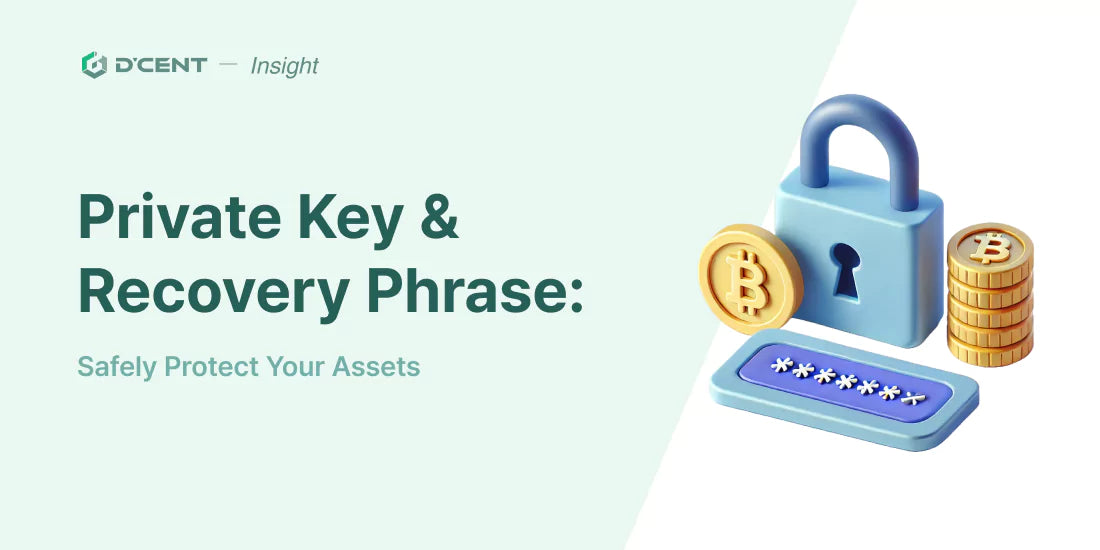Did you find this article helpful?
Sharing it takes less than 20 seconds, but we spent over 20 hours crafting it to bring you valuable insights. Help others by spreading the knowledge! 🚀

As of 2023, there are over 1,000 blockchain networks listed on CoinMarketCap, covering not only Bitcoin and Ethereum but also a wide range of other blockchains, including networks created through Layer 2 solutions. This diversity means that each blockchain uses unique private keys and addresses, and within a single blockchain network, users can have multiple keys and addresses. With so many private keys, how can they be conveniently managed within a wallet? In this blog, we will explore private keys—the unique proof of ownership in blockchain networks—and recovery phrases (often called mnemonic or seed phrases) that are essential for managing and securing access.
In blockchain, a private key is the essential information that allows a user to own and control digital assets. The private key is a unique string generated using hash functions and encryption algorithms, and it pairs with a public key. A private key must be kept strictly confidential, as it grants the user the authority to transfer assets or execute smart contracts.
Typically, a private key is a 256-bit number, meaning there are approximately 10^77 possible keys. This number is so large that it’s practically incomprehensible; no person or computer could attempt all possible combinations. For perspective, the estimated number of atoms in the observable universe is around 10^80, comparable to the total possible private keys. This makes guessing or brute-forcing a private key nearly impossible. The security of blockchain rests on this vast number, making it essential for users to manage their private keys securely.
Private keys can be generated in various ways, depending on the platform the user is using. Typically, private keys are created through wallet applications or key generation software. Here are some common methods for generating a private key:
Most cryptocurrency wallets have built-in private key generation functions. When a user creates a wallet, the wallet software automatically generates a private key along with its corresponding public key.
Common cryptocurrency wallets:
These wallets typically display the generated private key not as a string of random letters and numbers, but in the form of a 12- or 24-word mnemonic phrase (or seed phrase) that is easy for users to recognize and store.
Example of a private key:
c9a3f5b0d18f6d32d9e4b7a3cfa0e7bf98f3f0db283f5cb1d48f6b3a4c4e7d5a
In other words, the 12 or 24 recovery words displayed in the wallet represent the private key. These words are essential for private key recovery, and users should store them securely.

Developers often use programming languages and libraries to generate private keys. Libraries such as Python’s ecdsa and bitcoinlib provide functions for generating private and public key pairs. For instance, here’s a method to generate a private key using Python:
from ecdsa import SigningKey, SECP256k1
private_key = SigningKey.generate(curve=SECP256k1)
print(private_key.to_string().hex())
This approach is useful for developers and advanced users and is commonly used when software developers integrate private key generation functionality into their applications.
When using multiple blockchains, managing private keys becomes challenging for users, necessitating a standardized, easily recoverable way to generate keys. To address this, all keys created within a wallet can be derived from a single piece of information called the master seed. A seed phrase translates the master seed into easy-to-read words, so as long as the user knows these words, they can recover their wallet even if it’s lost, and even recreate the same wallet in another application using the same recovery phrase.
Modern decentralized wallets support 12- or 24-word phrases (or secret phrases). Generally, the more words in the phrase, the stronger the security. The order of the words is also crucial; if the order is changed, a different key is generated, making wallet recovery impossible. The most widely used method to create a recovery phrase is #BIP39 (Bitcoin Improvement Protocol 39). Proposed by the Bitcoin development community, BIP39 enables wallets to securely store and easily recover private keys.
When a mnemonic phrase is input under BIP39, it generates a unique seed. This seed is used to derive private keys in a cryptocurrency wallet, enabling users to create multiple addresses from it. Here’s a brief overview of how BIP39 operates:
As explained above, it is nearly impossible for a third party to randomly guess or access a private key. However, unfortunately, many users fail to manage their private keys securely, leading to cases of keys being leaked or stolen. If a private key is lost or exposed, all assets controlled by that key are at risk. Therefore, securely storing your private key is essential. Here are some recommended methods for private key storage:
If a private key is lost, there are very few ways to recover assets. However, recovery is possible in certain cases. Here are some methods for private key recovery:
The private key is the only element that proves ownership of digital assets, making it crucial to understand how to generate, store, and recover it securely. By choosing a secure wallet based on individual needs, thoroughly safeguarding the recovery phrase, and preventing private key exposure, users can manage their blockchain assets safely. Additionally, hardware wallets like #D'CENT offer an advanced security feature called the #Secret Phrase, allowing users to add an extra word to the standard 24-word seed phrase to create a completely new private key. This means that even if someone gains access to the seed phrase, they cannot regenerate the same wallet without knowing the 25th word. This secret phrase, chosen by the user, can be up to 8 characters long with numbers and letters. Since the user creates this phrase, it’s important to select a memorable word carefully.
Did you find this article helpful?
Sharing it takes less than 20 seconds, but we spent over 20 hours crafting it to bring you valuable insights. Help others by spreading the knowledge! 🚀